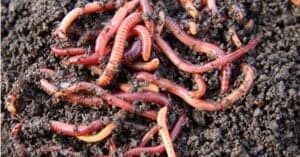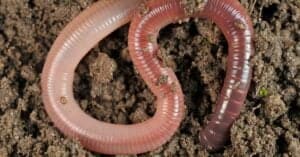Tapeworms – some of the world’s most feared parasitic worms! Even spelling this word can cause a stomachache! As disgusting as they are, these worms are living creatures that need to eat to survive. But what do they eat and how? You’ll soon find out! Keep reading to learn everything about a tapeworm’s diet and what symptoms they cause in animals and humans.
What Are Tapeworms?

Tapeworms live in the digestive tract and related ducts of hosts.
©iStock.com/Artur Plawgo
The term “tapeworm” refers to some parasitic worm species in the Cestoda class. These worms are part of the Eucestoda subclass.
Tapeworms live in the digestive tract and related ducts of hosts. They have white, elongated bodies, with a size ranging from a few inches to up to 82 feet. Most tapeworms have the same organs grouped in sets that duplicate down the body length.
These parasites can live up to 20 years!
What Do Tapeworms Eat?
Tapeworms eat everything their animal or human hosts eat. Since they reside in their hosts’ intestines, they have no choice but to conform to their diet. These parasitic worms feed on partially digested food in the intestines.
Some sources state that tapeworms delight in sugar, so avoiding foods high in sugar is widely recommended if you suspect you have an infection. However, there’s still no official confirmation that this is indeed what causes a rapid tapeworm spread.
Moreover, many sources recommend eating many vegetables, fruits, and various types of meat because tapeworms “don’t like them” and will rather starve to death than absorb the nutrients! Other sources state they don’t like sour products, raw garlic, pomegranates, carrots, and pumpkin seeds.
So what exactly do tapeworms eat? This will remain a mystery until scientific evidence shows otherwise!
How Do Tapeworms Eat?

Tapeworms attach their heads to the intestine’s inner wall and absorb the nutrients from the food the host ingests.
©iStock.com/
Tapeworms have no mouth or digestive tracts. So how do they eat? They have a layer of microtriches (hair-like filaments throughout their body wall surface) that absorb the nutrients. Once they’re in the digestive tract of their hosts, tapeworms attach their heads to the inner wall of the intestine and absorb the nutrients from the food the host ingests.
What Do Tapeworms Do to Animals?
While we can’t discuss all animals, we can talk about dogs and cats – two of the most popular pets. The CDC states that tapeworms don’t usually harm dogs or cats. The only symptom they may show is weight loss; that is if the infection is severe.
Another symptom is skin irritation. If you notice your dog or cat dragging its anus across the ground, there’s a possibility it’s infected with tapeworms, and the proglottids irritate the skin around the anus.
Even though tapeworms aren’t generally considered a major threat to your pet’s health, you should still check with the veterinarian for treatment. If the infection spreads, other health issues may appear.
What Do Tapeworms Do to Humans?
If the infection is not severe, the host (human) won’t have any noticeable symptoms. Still, if you notice you have any or more of the below symptoms that last longer than usual and that don’t have an established cause, you should test yourself for a tapeworm infection:
- Weakness
- Loss of appetite
- Nausea
- Diarrhea
- Dizziness
- Abdominal pain
- Salt craving
- Sudden weight loss
If the parasitic infection spreads or the tapeworm grows large enough, it can block the appendix, eventually causing appendicitis. It can also block the bile ducts responsible for carrying bile from the liver to the intestine. The pancreatic ducts can also be blocked.
Furthermore, suppose the infected person has symptoms like headaches, visual impairment, seizures, hydrocephalus, meningitis, or dementia. In that case, this may indicate that the infection caused brain and central nervous system impairment.
If tapeworms migrate and form cysts in other organs like the lungs or liver, the cysts can grow and stop normal organ functioning.
How Do You Get Rid of Tapeworms in Humans?

There are specially-designated anthelmintic drugs that are effective against tapeworms.
©iStock.com/selvanegra
Consulting with your doctor is the first step to treating tapeworms. There are specially-designated anthelmintic drugs that are effective against tapeworms. The type of drug, the dosage, and the treatment duration should be established only by your doctor and only after you’ve already been tested for parasites.
What’s a Tapeworm Diet?
Believe it or not, there’s something called a “tapeworm diet.” No, this doesn’t refer to what tapeworms eat. It refers to ingesting a pill containing a tapeworm egg inside (or a tapeworm, nobody knows!), which later hatches, and a nicely-built tapeworm starts growing inside the body.
It’s believed that this “idea” came from the Victorian Era when beauty ideals went to the extremes: pale skin, dilated eyes, tiny waist, red cheeks and lips, and no fat. At the time, “sanitized tapeworms” were advertised as solutions for eating as much as you want and not getting fat – after all, the tapeworm absorbs all the nutrients, right? However, historians couldn’t confirm whether people did indeed resort to the tapeworm diet.
Unfortunately, this habit and parts of these ideals have survived until now, and people resorting to this diet don’t consider the major risks they’re taking by ingesting tapeworm pills. Although rare, there are isolated cases in which people either ingested a tapeworm to lose fat or were willing to go with it if that meant they could lose a few pounds.
Luckily, the Food and Drug Administration has banned these pills.
Up Next:
- The Best Dewormer for Cats: Updated for 2022
- Can You Get Worms From Dogs? What Science Says
- The 6 Most common ways dogs get worms (and how to prevent them)
The photo featured at the top of this post is © iStock.com/Artur Plawgo
Sources
- Mayo Clinic, Available here: https://www.mayoclinic.org/diseases-conditions/tapeworm/symptoms-causes/syc-20378174
- CDC, Available here: https://www.cdc.gov/parasites/dipylidium/faqs.html
- Healthline, Available here: https://www.healthline.com/health/diet-and-weight-loss/tapeworm-diet#origins
- Atlas Obscura, Available here: https://www.atlasobscura.com/articles/the-horrifying-legacy-of-the-victorian-tapeworm-diet
Thank you for reading! Have some feedback for us? Contact the AZ Animals editorial team.






